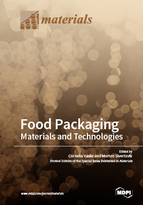Food Packaging: Materials and Technologies
A special issue of Materials (ISSN 1996-1944).
Deadline for manuscript submissions: closed (4 January 2019) | Viewed by 50715
Special Issue Editors
Interests: polymeric (bionano)composites; biomaterials; biodegradation; polymer compatibility and biocompatibility; kinetics and thermodynamics of polymeric systems; food packaging, (active, bioactive, smart, (bio)degradable); drugs delivery; recovery of polymer wastes by destructive and non-destructive procedures; environmental pollution and protection; smart polymers
Special Issues, Collections and Topics in MDPI journals
Special Issue Information
Dear Colleagues,
Because of the increasing pressure on both food safety and packaging/food waste, the topic is important both for academics, applied research, industry and also for environment protection. Different materials, such as glass, metals, paper and paperboards, and non-degradable and degradable polymers, with versatile properties, are attractive for potential uses in food packaging.
Food packaging is the largest area of application within the food sector. Only the nanotechnology-enabled products in the food sector account for ~50% of the market value, with and the annual growth rate is 11.65%. Technological developments are also of great interest. In the food sector, nanotechnology is involved in packaging materials with extremely high gas barriers, antimicrobial properties, and also in nanoencapsulants for the delivery of nutrients, flavors, or aromas, antimicrobial, and antioxidant compounds.
Applications of materials, including nanomaterials in packaging and food safety, are in forms of: edible films, polymer nanocomposites, as high barrier packaging materials, nanocoatings, surface biocides, silver nanoparticles as potent antimicrobial agents, nutrition and neutraceuticals, active/bioactive packaging, intelligent packaging, nanosensors and nanomaterial-based assays for the detection of food relevant analytes (gasses, small organic molecules and food-borne pathogens) and bioplastics.
Since you are working in this intriguing area, it is our pleasure to invite you to contribute a full paper/letter/communication/review to this Special Issue. The authors are encouraged to submit manuscripts reporting unexpected results providing they can present scientifically-spotless explanations.
Dr. Cornelia Vasile
Dr. Morten Sivertsvik
Guest Editors
Manuscript Submission Information
Manuscripts should be submitted online at www.mdpi.com by registering and logging in to this website. Once you are registered, click here to go to the submission form. Manuscripts can be submitted until the deadline. All submissions that pass pre-check are peer-reviewed. Accepted papers will be published continuously in the journal (as soon as accepted) and will be listed together on the special issue website. Research articles, review articles as well as short communications are invited. For planned papers, a title and short abstract (about 100 words) can be sent to the Editorial Office for announcement on this website.
Submitted manuscripts should not have been published previously, nor be under consideration for publication elsewhere (except conference proceedings papers). All manuscripts are thoroughly refereed through a single-blind peer-review process. A guide for authors and other relevant information for submission of manuscripts is available on the Instructions for Authors page. Materials is an international peer-reviewed open access semimonthly journal published by MDPI.
Please visit the Instructions for Authors page before submitting a manuscript. The Article Processing Charge (APC) for publication in this open access journal is 2600 CHF (Swiss Francs). Submitted papers should be well formatted and use good English. Authors may use MDPI's English editing service prior to publication or during author revisions.
Keywords
- food packaging
- materials
- nanomaterials
- nanocoating
- edible films
- Technology
- smart packaging/polymers
- bionanocomposites
- Kinetics/Thermodynamics of migration/release into food products
- Active/natural compounds







